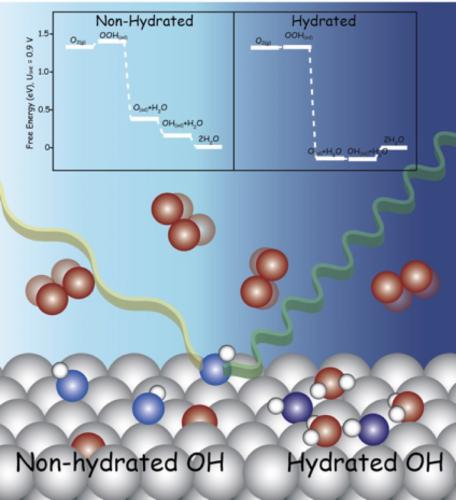In situ x-ray spectroscopy identification and DFT simulations of oxygenated intermediates on a platinum fuel cell cathode. The study shows two types of OH (non-hydrated OH and hydrated OH) co-exist on a fuel cell cathode with distinct activities.
The performance of polymer electrolyte membrane fuel cells is limited by the reduction at the cathode of various oxygenated intermediates in the four-electron pathway of the oxygen reduction reaction. Here, SLAC scientists used in situ X-ray photoelectron spectroscopy and density functional theory (DFT) calculations and directly probe the correlation between the adsorbed species on the surface and the electrochemical potential. This study shows that OH intermediates on the cathode surface occur in hydrated and non-hydrated configurations. In particular, near the open-circuit potential, non-hydrated OH is the dominant surface species. This study not only confirm the presence of adsorbed OH during ORR conditions but, most importantly, demonstrate that ORR processes involving hydrated OH and non-hydrated OH, coexisting under operating conditions. We evaluated thermodynamic barriers associated with the overall ORR processes using DFT calculation. At 0.9 V, the thermodynamic barrier is 0.07 eV in the non-hydrated pathway, corresponding to the conversion of O2 to OOH. On the other hand, in the hydrated pathway, it becomes 0.15 eV for the removal of hydrated OH. This study shows that the hydration of OH hinders the ORR processes. Extending the stability of the non-hydrated OH at high cell potentials will improve the overall ORR activity.
The importance of non-hydrated OH for the ORR at high potentials explains the enhanced ORR activity of Pt in limited hydration environments, such as in hydrophobic ionic liquids, in the presence of particular aqueous ions and on the confined surface. This new insight into the subtle interplay between non-covalent hydrophobic and hydrophilic interactions can inspire the design of new catalysts, not only for the ORR but also for other relevant electrochemical reactions.

